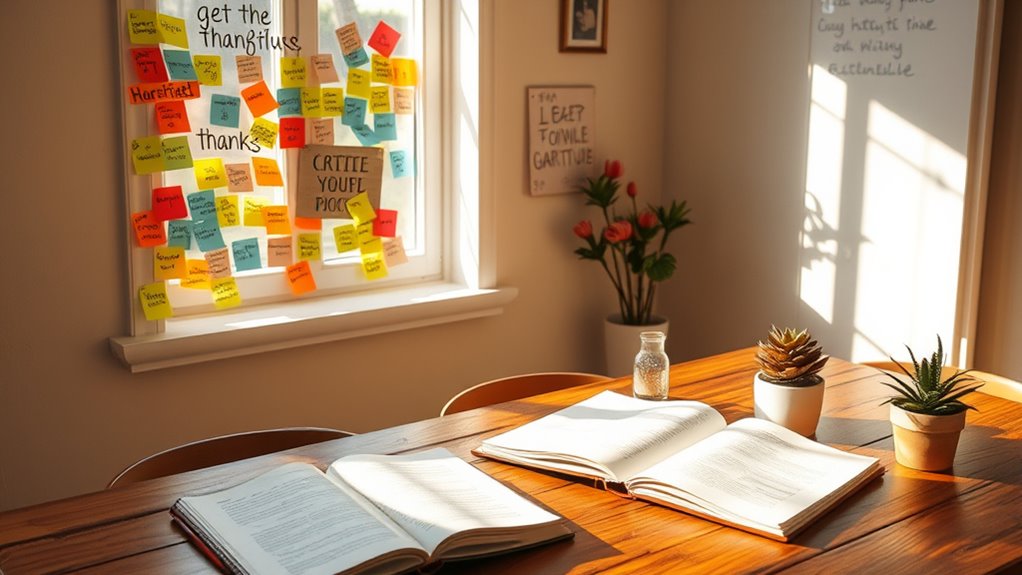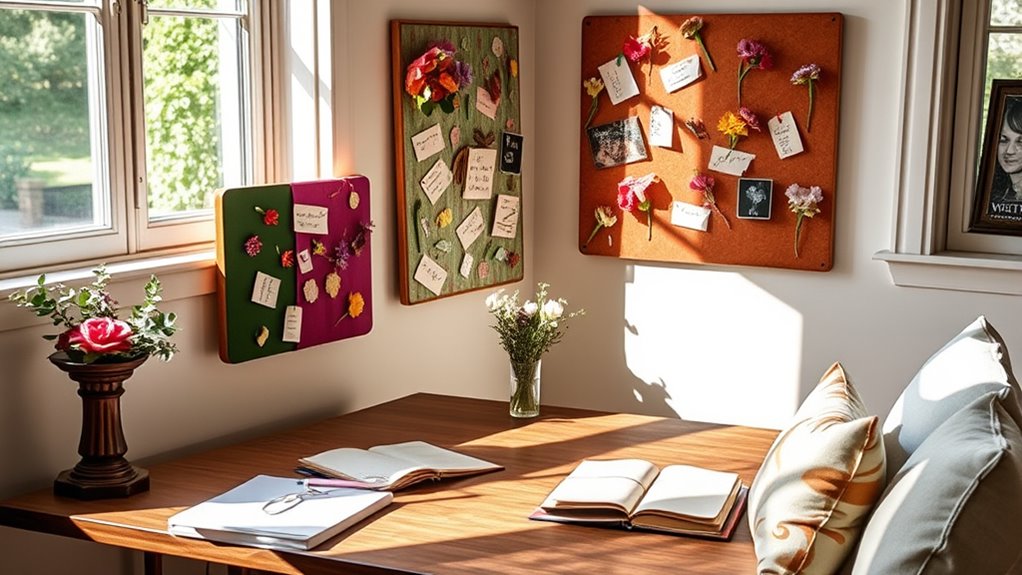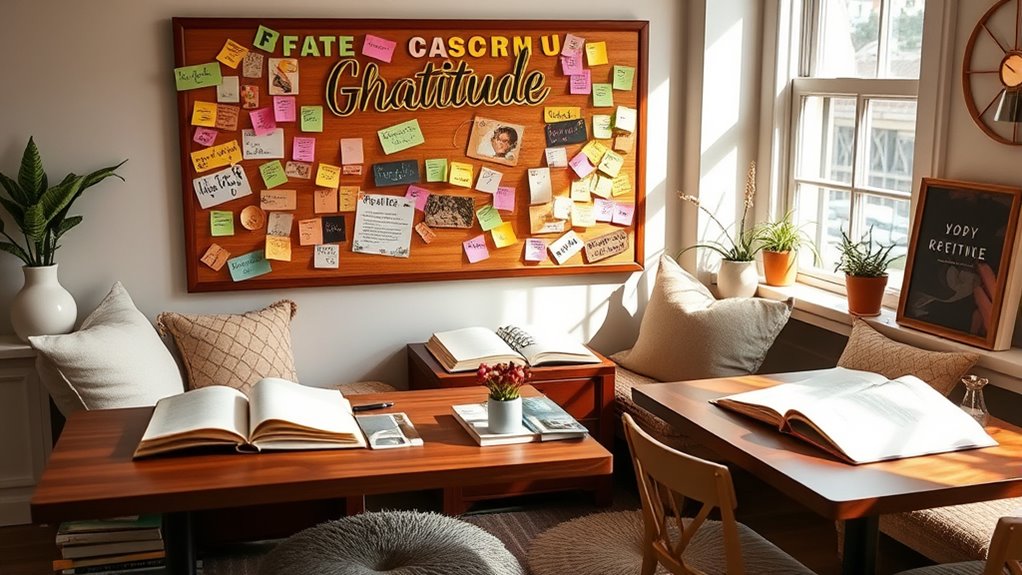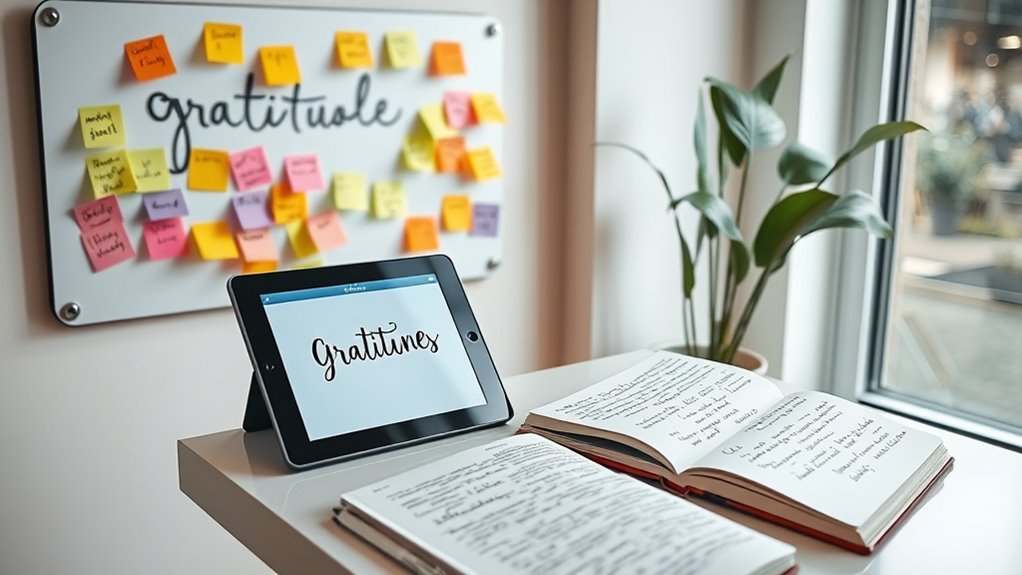Creating gratitude boards and journaling stations transforms everyday spaces into powerful tools for boosting well-being. By design, these spaces encourage mindfulness, emotional awareness, and positivity through colorful decorations, inspiring quotes, and organized supplies. Consistent use helps reduce stress, build resilience, and foster a gratitude mindset. Whether at home or in classrooms, thoughtful features make gratitude routines enjoyable and meaningful. Keep exploring to discover more creative ideas and tips to personalize your gratitude space.
Key Takeaways
- Use bright colors and visual cues to make gratitude boards and journaling stations engaging and inspiring.
- Design accessible layouts with dedicated spaces for writing, photos, and decorative elements.
- Incorporate prompts, quotes, or textures to motivate regular gratitude reflections.
- Establish routines, such as daily gratitude notes or reflection sessions, to promote consistency.
- Enhance spaces with supplies like markers, stickers, and keepsakes to encourage creativity and emotional connection.
Benefits of Gratitude Practices in Daily Life

Practicing gratitude daily can considerably boost your overall well-being. When you engage in simple mindfulness exercises, you become more aware of your emotions and surroundings, fostering emotional awareness. This heightened awareness helps you recognize positive aspects of your life, even during challenging times. Regular gratitude practices can reduce stress, increase happiness, and improve your outlook. By focusing on what you’re thankful for, you shift your mindset from scarcity to abundance. Incorporating gratitude into your routine encourages a more optimistic perspective, which benefits your mental health. Over time, these habits strengthen your resilience and emotional balance. Developing a growth mindset can further enhance your ability to adapt and find opportunities for gratitude in every situation. Ultimately, consistently practicing gratitude helps you cultivate a more content and fulfilled life, making everyday experiences more meaningful.
Creating an Engaging Gratitude Board at Home

Creating a gratitude board at home is an engaging way to regularly remind yourself of the positive aspects of life. To make it truly inviting, consider your color schemes—bright, cheerful colors can boost your mood, while calming tones promote reflection. When planning space placement, find a spot that’s visible daily, like near your mirror or workspace, ensuring it catches your eye often. Keep the layout organized but flexible, allowing space for new notes or photos. Use a mix of textures and materials to add visual interest and encourage interaction. The goal is to create a welcoming, inspiring focal point that encourages daily gratitude. Incorporating visual appeal through thoughtful design can enhance your emotional connection to the space. With thoughtful color choices and strategic space placement, your gratitude board becomes a meaningful part of your home environment.
Designing a Functional Journaling Station for Reflection

A well-designed journaling station can seamlessly integrate reflection into your daily routine, building on the positivity fostered by your gratitude board. To create a functional space, choose a dedicated spot with enough surface area for your supplies. Use colorful markers to add vibrancy and inspire creativity, while decorative tapes can help organize sections or add personal touches. Consider these key elements:
- A comfortable, accessible surface for writing, encouraging regular reflection.
- Clear storage for supplies like markers, tapes, and notebooks, keeping everything organized.
- Visual cues such as inspiring quotes or images to motivate your journaling practice.
- Incorporating regional legal resources can help if you seek guidance on personal development or counseling options to support emotional well-being.
Materials and Supplies for Building Your Gratitude Space

To create an inspiring gratitude space, you’ll want to gather materials that spark your creativity and encourage personal expression. Think about colorful markers, decorative papers, and meaningful items that reflect your personality. Having the right tools on hand makes it easier to personalize your gratitude board or journaling station. Incorporating functional design elements can also enhance comfort and usability in your space.
Materials for Creativity
Building your gratitude space requires gathering a variety of materials and supplies that inspire creativity and personal expression. To make your space engaging, focus on art supplies such as colorful markers, paints, and brushes that allow you to create vibrant, meaningful visuals. Incorporate decorative accents like inspiring quotes, unique stickers, or textured tapes to add personality and warmth. These elements serve as visual reminders of positivity and gratitude. Consider including items that evoke emotion, like photographs or keepsakes, to deepen your connection to your space. Remember, the goal is to foster an environment that sparks joy and reflection. By choosing thoughtful art supplies and decorative accents, you create a personalized haven that encourages ongoing gratitude and creative expression. Additionally, using textured materials such as fabric swatches or embroidery can add a tactile dimension that enhances your textile art experience.
Tools for Personal Expression
Equipping your gratitude space with the right tools empowers personal expression and makes the practice more meaningful. Use visual storytelling supplies like colorful markers, stickers, and printed photos to help you craft compelling stories about what you’re grateful for. Incorporate notebooks, washi tape, and decorative papers to create a personalized journaling station that encourages emotional release. These materials allow you to visually represent your feelings and experiences, making it easier to connect with your gratitude on a deeper level. By choosing expressive tools, you create a space where you can freely explore your emotions and share your journey. The right supplies turn your gratitude practice into a dynamic outlet for reflection, fostering greater awareness and emotional well-being. Additionally, understanding WWE Raw’s financial impact can inspire you to recognize the value of dedication and strategic resource use in your personal growth.
Tips for Maintaining Consistency and Engagement

Maintaining consistency and engagement with gratitude boards and journaling stations can be challenging, but establishing simple routines helps keep these practices fresh and meaningful. To stay committed, focus on effective time management by scheduling dedicated moments each day. Use accountability strategies, like sharing goals with friends or setting reminders, to reinforce your commitment. Consider these tips:
Establish simple routines and accountability to keep your gratitude practices consistent and meaningful daily.
- Set a specific time daily to reflect, ensuring it becomes a habit.
- Track your progress to see growth and stay motivated.
- Celebrate small wins to reinforce the positive impact of your routine.
Additionally, understanding the importance of family dynamics can deepen your appreciation for the relationships you acknowledge in your gratitude practice. These approaches help deepen your connection to gratitude practices, making them a natural part of your life. Consistency is key, and integrating these strategies ensures your engagement remains genuine and sustainable.
Incorporating Gratitude Boards Into Educational Settings

Incorporating gratitude boards into your classroom can boost student engagement and create a positive atmosphere. When students regularly share what they’re thankful for, it encourages a mindset of appreciation and kindness. This simple addition can transform your classroom into a space focused on growth and positivity. Integrating positive psychology principles can further enhance the benefits of gratitude practices, fostering emotional well-being among students.
Classroom Engagement Strategies
Since gratitude boards foster a positive classroom environment, they can considerably boost student engagement. Incorporating them alongside mindfulness exercises encourages students to reflect on their feelings and develop emotional awareness. This practice helps students connect with their emotions and creates a sense of belonging. To maximize engagement, consider these strategies:
- Use gratitude boards as a daily reflection tool, prompting students to share moments of emotional awareness.
- Incorporate short mindfulness exercises before or after sharing, helping students center themselves.
- Encourage peer interactions by reading and discussing each other’s gratitude entries, fostering empathy and connection.
- Integrate positive reinforcement to motivate consistent participation and celebrate students’ emotional growth.
These approaches deepen students’ understanding of their emotions while making the classroom a more inclusive space. This active engagement motivates students to participate meaningfully and build resilience.
Promoting Positive Mindsets
Integrating gratitude boards into educational settings can substantially foster positive mindsets among students. When you incorporate mindfulness exercises, students learn to focus on the present moment, reducing stress and promoting emotional resilience. Encourage them to write gratitude affirmations on the boards, reinforcing positive self-talk and appreciation. These practices help shift attention from challenges to strengths, cultivating optimism and self-compassion. Regularly engaging with gratitude boards creates a culture of positivity, where students feel seen and valued. As they reflect on what they’re thankful for, their outlook becomes more hopeful and resilient. Incorporating elements from cryptocurrency innovation, such as digital tracking of gratitude progress, can further motivate students to maintain positive habits. Combining mindfulness exercises with gratitude affirmations on these boards empowers students to develop a lasting, positive attitude toward learning and life, ultimately enhancing their overall well-being.
Using Technology to Enhance Gratitude Journals

Technology offers exciting ways to make gratitude journaling more engaging and accessible. Digital journaling and gratitude apps allow you to record your thoughts anytime, anywhere, making it easier to stay consistent. Here are three ways technology deepens your practice:
Embrace digital tools to make gratitude journaling more engaging, flexible, and personalized for a deeper daily practice.
- Instant Reflection – Capture spontaneous moments of gratitude with quick entries, strengthening your mindfulness.
- Personalization – Customize layouts, prompts, and reminders to suit your mood and goals.
- Connectivity – Share your gratitude moments with friends or community groups for added encouragement and inspiration.
Using these tools, you can transform your gratitude journaling into a dynamic, interactive experience that fosters positivity and growth every day. Embrace technology to enhance your journey of appreciation and self-awareness.
Inspiring Examples and Creative Ideas for Gratitude Spaces

Creative gratitude spaces can turn everyday environments into inspiring hubs of appreciation. You might set up a dedicated corner with a colorful bulletin board for mindful reflection, encouraging daily notes of gratitude. Incorporate simple gratitude rituals, like writing three things you’re thankful for each morning or evening, to build consistency and deepen your appreciation. Use inspiring quotes or photos to motivate and remind you of positivity. Consider creating a gratitude jar, where you drop in notes throughout the week, then read them during reflection time. These spaces foster a sense of mindfulness and help integrate gratitude into your routine. By designing engaging and personal areas for gratitude, you turn ordinary moments into powerful practices that cultivate lasting joy and awareness.
Frequently Asked Questions
How Often Should I Update or Refresh My Gratitude Board or Journal?
You should refresh your gratitude board or journal weekly or biweekly to keep it meaningful and engaging. Use frequency tips like setting reminders or marking a specific day to update. Incorporate refresh strategies such as adding new gratitude prompts, changing layouts, or including fresh photos. Regular updates help you stay mindful and motivated, ensuring your gratitude practice remains a positive, evolving part of your routine.
Can Gratitude Boards Help Improve Mental Health and Emotional Well-Being?
Think of gratitude boards as a lighthouse guiding your emotional ship through stormy seas. They can profoundly boost your mental health and emotional well-being by fostering mindfulness techniques, helping you focus on positive moments. As you regularly update your board, you build emotional resilience, making it easier to navigate life’s challenges with a calmer, more optimistic outlook. This daily practice anchors you in gratitude, promoting lasting emotional strength.
What Are Some Common Challenges When Maintaining a Gratitude Practice?
You might struggle with finding time to maintain your gratitude practice, especially busy schedules or forgetfulness. Overcoming skepticism can also be tough if you doubt its benefits or feel it’s just a fad. To stay consistent, set small, achievable goals and remind yourself of how gratitude boosts your mood. Keep an open mind, and remember that even brief daily reflections can make a big difference in your emotional well-being.
How Can I Personalize My Gratitude Station to Reflect My Personality?
Did you know people who personalize their gratitude station are 30% more likely to stick with it? To reflect your personality, try creative customization by choosing colors, themes, or images that resonate with you. Add motivational quotes, your favorite artwork, or photos. Incorporate meaningful objects or DIY elements. These personalization ideas make your gratitude station uniquely yours, inspiring you daily and turning gratitude into a joyful, tailored experience.
Are There Digital Alternatives to Physical Gratitude Boards and Journals?
Yes, there are digital alternatives to physical gratitude boards and journals. You can use virtual gratitude tools like apps or online platforms that let you record, organize, and reflect on what you’re thankful for anytime, anywhere. These tools often include features like reminders, multimedia entries, and sharing options, making it easy to stay consistent and personalize your gratitude practice. They’re a convenient way to keep gratitude front and center in your daily life.
Conclusion
When you set up a gratitude board or journaling station, you might find yourself surprised by how often you return to them—almost like they’re quietly guiding you toward more mindful moments. It’s funny how a simple space can inspire consistent reflection, turning everyday gratitude into a natural part of your routine. So, start creating yours today—you never know what little joys might unexpectedly brighten your days just when you least expect it.









